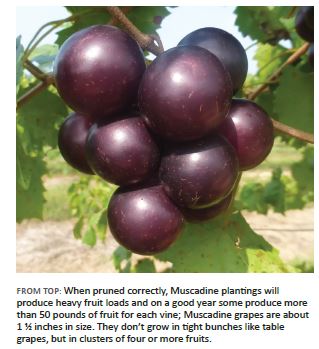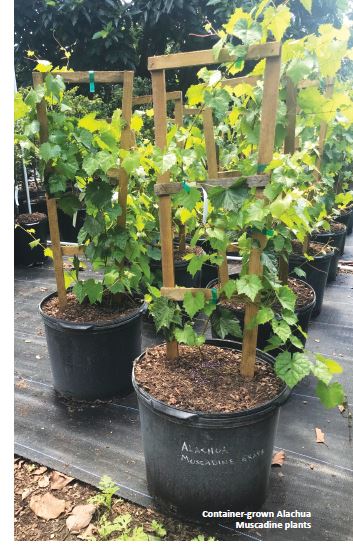Thought by some people to be a great Texas secret, the Muscadine grape has burst onto the marketplace and into home gardens in recent years. Thanks to effective and positive experimentation and breeding, the Muscadine grape has improved tremendously in size and taste with features that rival top quality table grapes.
The vines need little care once established adapting well to hot and humid climates. Some fifteen varieties are noted to produce excellent superior fruit from July through September. Modern Muscadine grapes boast a thin skin, tender pulp and a sweet taste.
Muscadine are native to southeastern United States from Delaware to Florida and west into Texas. Truly “a fruit for the South”, they were discovered by early colonists and have been a favorite fruit of Southerners ever since. A vine growing on Roanoke Island is thought to be a 400-hundred-year-old grapevine known as the “Mother Vine.”
Muscadine vines can be male or female and must be grown near each other to propagate, so most home-growers opt for the self-fertile variety that is said to have “perfect” flowers.
The vines grow up to three feet in a single year and may live for two hundred years. With notably large berries, they grow in a variety of colors and sizes.
Muscadines prefer hot humid climates making them an ideal choice of grape for our region. Since these plants require full sun and well-draining soil, the perfect site would be one that gets at least six hours of sun daily.
 Prepare your site by adding a mix of organic material assuring that the vines will thrive. Next build a trellis for the necessary support of the vines.
Prepare your site by adding a mix of organic material assuring that the vines will thrive. Next build a trellis for the necessary support of the vines.
A strong supporting structure should be constructed using sustainable materials like pressure treated posts to string wire between that will be the trellis upon which the vines will stretch and grow. A strong trellis is optimal for the weighty vines that will eventually cover it.
Growing muscadine grapes over a garden arch or a pergola may be aesthetically pleasing but, in the end, not practical as needed management would be difficult and neglect probable, resulting in poor fruit production.
Plant bare-root vines in the spring by digging a deep and wide hole against the trellis, placing the ball into the soil and fanning out the roots. It’s important to give each vine plenty of space so they can sprawl along the trellis.
Once you have planted the vines, backfill with soil and tamp down. Keep the soil moist throughout the first year until the vines can draw sufficient moisture on their own.
 If possible, the use of one-year old container-grown plants may be preferred as they are hardier, easier to deal with and can be planted anytime while the bare-root style should be set in late-winter. Plant container-grown plants in a large wide hole that will accommodate the plant well, then partially back-fill the hole with topsoil, pack firmly, and mulch with compost to retain moisture.
If possible, the use of one-year old container-grown plants may be preferred as they are hardier, easier to deal with and can be planted anytime while the bare-root style should be set in late-winter. Plant container-grown plants in a large wide hole that will accommodate the plant well, then partially back-fill the hole with topsoil, pack firmly, and mulch with compost to retain moisture.
Muscadines require routine maintenance, careful pruning away of old dead side shoots leaving the most robust of vines and securing these to the trellis. Repeat this pruning as needed selecting those branches that appear most substantial for fruiting.
Fertilizing is an important part of regular maintenance: apply ¼ pound of a balanced formula around each vine in the spring, continuing this procedure every six weeks into the summer. The addition of a magnesium fertilizer can ensure larger berries.
A shortage of magnesium will manifest itself as a yellowing in the shoots and older leaves and premature fruit fall. The application of Epsom salts broadcast evenly over a three-to-six-foot area around the plant will prevent this occurrence. Water well into the soil.
Muscadine grapes can need regular watering during dry periods for the first two years. Once the vines become established, water requirements are highest from bud-break until flowering. After flowering, watering should be limited to maintain the plant and maturing fruit without stimulating vigorous vegetative growth.
Although Muscadine grapes can be pest and disease resistant, on occasion there may be a need for applications of sprays to combat those problems that do arise. Most common insects would be the Japanese beetle, grape berry moth, and grape root borer. Diseases most common are bitter rot, angular leaf spot, ripe rot, powdery mildew, and black rot.
Using sprays of captan (a man-made fungicide) in the summer months of May, June, and July should control all of the above-mentioned pests and diseases except powdery mildew which may be eliminated with treatments of a sulfur product.
There are a number of triggers that can explain poor yield of Muscadine grapes. These include the lack of proper pruning, root competition from other plants and insufficient sun light. Other causes of poor yield can be powdery mildew, stink bug injury to fruit and lack of adequate pollination.
Unlike other grapes that ripen in clusters or bunches, Muscadine grapes ripen one berry at a time and are best harvested by hand. After collecting the grapes, there are several forms of preservation most notably jams and jellies. Other uses include as healthy snacks that are high in antioxidants or as a dessert wine that is very aromatic with flavors of ripe bananas or apples.
The future of muscadine grapes for Texas home gardeners looks promising with a growth of plenty of fresh fruit for two or more months every year requiring minimum maintenance.
A straightforward and uncomplicated method of propagating Muscadine grapes is called “root layering.” Simply bend a healthy shoot down to the ground, burying a portion of it but leaving the tip exposed. After the vine goes dormant in the fall, dig up the shoot cut it into sections and plant.
Cultivars of muscadines are usually selected based on a large berry size, sweet flavor, disease resistance, and productivity. The self-fruitful cultivars have shown to have higher productivity levels.
Perfect Flowered and Self-fruiting Cultivars These cultivars have both male and female parts:
Alachua: black fruit, good yield, a popular fresh market fruit
Carlos: good quality medium sized berry, good for juice, wine, jams and jellies
Cowart: Black medium fruit of good quality, disease resistant, vigorous growth
Doreen: Bronze berries, highly vigorous, productive, very high disease resistance
Ison: Black medium to large fruit, high vine vigor and high yields, disease resistant, use for jelly, juice or wine
Nesbitt: Medium to large black fruit, most cold tolerant
Tara: Early ripening, bronze medium/large fruit, good flavor
Triumph: Good production, bronze colored fruit, excellent flavor
Included here is a tempting recipe for a chicken dish using Muscadine grapes.
Bon Appetit!
Drunken Chicken with Muscadine Grapes and White Wine
By Sandra Gutierrez
This recipe calls for a Dutch oven that will allow flavors from the various ingredients to seep into the chicken making it moist and extra delicious.
Ingredients:
4 ½ pounds chicken cut into 10 serving pieces
1 ½ tsp salt
½ tsp black pepper
2 tablespoons extra virgin oil
5 cups thinly sliced Vidalia onion
3 large garlic cloves, thinly sliced
2 tablespoons Dijon mustard
1 Bay leaf
½ tsp red pepper flakes
1 cup white wine
3 cups muscadine grapes, halved and seeded
¼ cup chopped parsley leaves
Instructions:
Pat chicken dry, season with salt and pepper
Heat oil in large Dutch oven, brown chicken pieces on all sides, transfer to a platter
Discard all but 1 tablespoon of oil left in pan, add garlic, mustard, bay leaf, and red pepper flakes, cook stirring for 30 seconds or until garlic is fragrant.
Add wine stirring and scraping the bottom of pan, bring to a boil.
Return chicken to Dutch oven, cover, reduce heat to low and simmer for fifteen minutes.
Add the grapes and stir well, cover and simmer for fifteen minutes or until the chicken is cooked through and juices run clear when chicken is pierced.
Adjust taste with salt and pepper. Transfer to serving platter and sprinkle with parsley. Serves six.